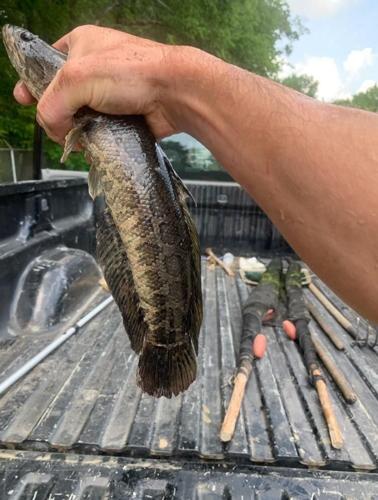PUXICO, Mo. â Fish mounts and a stuffed bobcat watched over the dining room tables on a recent day at Duck Creek Landing. Fred the rattlesnake, mouth full of exposed fangs, was forever coiled up in a jar of clear liquid at the bar.
And Karen Crotts, catering to southeast Missouri swampland anglers, hustled minnows for $2.25 a dozen, tubes of crickets for $6.
Crotts and some customers were just finding out about a northern snakehead fish that was caught nearby. Told that the invasive species is a voracious predator that can live out of water for days, her thoughts immediately went to an older man whoâd been there that morning to buy bait.
He may have been going out to catch one.
âI donât know if he was joking or not,â said Crotts, 44.

State workers caught the second reported northern snakehead in Missouri on May 19, 2023 at Duck Creek Conservation Area.
The second Missouri snakehead in four years was caught May 19, deeper into the state than expected. Wildlife officials sounded the alarm. Recent reporting signaled that many people still arenât aware of the incident, potential impact, nor what to do if they hook one.
People are also reading…
Originally from east Asia, where the fish are a delicacy and considered to have healing powers, northern snakeheads are particularly difficult to contain. Not just because they can wiggle across muddy land and grow to nearly 3 feet long.
They reproduce quickly. Unlike native game fish, such as largemouth bass, which contribute a lot to the stateâs $400 million sports fishing industry, northern snakehead parents tend to stick around to aggressively guard their young, well after each enormous hatch. Sharp teeth help.
In 2002, the federal government banned the import and interstate transport of live northern snakeheads in the U.S. Still, despite eradication efforts, they continue to flourish in some areas, including on the other side of Missouriâs southeastern border.
âThey are knocking on the door in Arkansas,â said Dave Knuth, a Missouri fisheries management biologist based in Cape Girardeau. âThey are a beast.â
And on the move.
âI didnât expect them to be this far up the state already,â he said.
In 2019, the first northern snakehead was reported caught in Missouri. That one came out of a ditch within the St. Francois River levee system in Dunklin County, on the far edge of the Bootheel. Then, on May 19, state workers using a net to catch bait for a youth jug-fishing clinic, pulled the second one out of Duck Creek Conservation Area. Knuth said the 13-inch fish, with âpython-likeâ black and tan coloring, was found in the same watershed, though about 70 river miles north from the first location.
Wildlife officials said they spent two days searching for additional northern snakeheads in the 6,318-acre conservation area and neighboring 21,582-acre Mingo National Wildlife Refuge. No others were found, but some are likely lurking there, at least in low numbers.
The conditions are a perfect breeding ground for northern snakeheads.

Leroy Romine, 86, fishes from his boat on Thursday, June 18, 2023, at Duck Creek Conservation Area in southeast Missouri. State workers caught a northern snakehead fish in the area on May 19.
Restoring wetlands
Many vow to drain the swamp in Washington, D.C. It already happened in southeast Missouri. To do it, they had to pull the plug on the whole watershed, otherwise it wouldnât work because of the inter-connectivity of the system.
So, in the early 1900s, a massive network of deep ditches was dug across 2 million acres of bottomland. The murky water mainly flowed to Arkansas. Forests were leveled. Land was turned into farming â soybeans, watermelons, rice â that continues to be a source of pride for the region.
Frank Nelson, a wetlands expert for the Missouri Department of Conservation, said there is also a sense of nostalgia for lost wildlife.
âThere are benefits to the swamp,â he said.
The Mississippi River, long before it was levied and channelized, would flood low-lying natural areas every year. Shallow sloughs at Duck Creek and Mingo wildlife areas mimic native wetlands. Trapped between Ozark hills to the immediate west, and Crowleys Ridge to the east, Nelson said drainage was more difficult. There have also been government efforts to protect lots of native creatures there, ranging from migratory birds, turtles and snakes, to amphibians, bats and all kinds of fish. Some species are very rare.
At Duck Creek, large fields are flooded and drained each year with the help of levees, water wells and a 1,800-acre reservoir connected to a network of man-made drainages and canals. The northern snakehead caught there in May came out of area 13, one week after a big rain. It was swimming in a receding pool, by a concrete water control structure in the middle of a field.

The invasive northern snakehead fish found on May 19, 2023 in this pool of water (right) at Duck Creek Conservation Area could have traveled through a nearby water-filled ditch like this one (left) in southeast Missouri.
âThe fish could have easily come in through the ditch system,â said Nicole Walker, a biologist there.
Depending on the time of year, and the stage of the wetland cycle, the area is popular for bird enthusiasts and duck, deer and turkey hunters. The big reservoir is well-known for fishing.
âItâs one of the best bluegill and pan fishing lakes in the state,â Walker said.
The conservation department says northern snakeheads are predatory fish that should be killed. But notices recently posted up at public bathrooms, a dock and other locations around Duck Creek Conservation Area werenât that explicit. They pointed out how to tell the difference between a northern snakehead and native bowfin, which is similar.
Tom Kilburn, 65, fishing from the bank of the reservoir on a recent day with his grandson, said he wonders if he caught a northern snakehead there last summer.
âWe didnât think anything about it, just chunked it up on the bank,â he said.

Tom Kilburn, 65, fishes Thursday, June 18, 2023, at Duck Creek Conservation Area in southeast Missouri. Kilburn said he thinks he may have caught a northern snakehead fish at Duck Creek last year, but at the time did not know what it was.
Leroy Romine, 86, was in the only boat on the reservoir, which was thick with lily pads and moss.
âI donât want to ever see one,â he said. âInvasive species, itâs just best that they never show up.â
As he fished, a drone buzzed around the area, spraying herbicide on invasive Bermuda grass and knotweed. Two or three times a year, wildlife officials also try to put a dent in the feral hog population by shooting at them out of helicopters.
Larry Underwood, 73, who lives nearby, was skeptical of the efforts to keep northern snakeheads out but wished the state well.
âItâs kind of like the hogs,â he said. âYou are going to eliminate that? Yeah, good luck.â
Battles elsewhere
Maryland is a popular case study of what can happen.
In May 2002, somebody caught an 18-inch fish out of a pond that looked strange enough to photograph before tossing back. It was soon identified as a northern snakehead. Then, another was caught in the same pond â this one 26 inches long.
Maryland wildlife officials responded to the scene to investigate. They used electricity to stun fish in the pond, which turned up 100 young northern snakeheads. Eradication was ordered. In September 2002, the whole pond was treated with rotenone, which killed over 1,200 northern snakeheads, as well as other fish.

The teeth of a northern snakehead fish caught in Maryland, which has seen a major expansion of the invasive species in the past 20 years. It's still unclear what impact they have on native species but they eat a lot of small and larger prey.
According to a , officials determined that the population had been started by three northern snakeheads purchased from a live market in New York and released in the pond. It was the first documentation that snakeheads were reproducing in Maryland. They were soon discovered in the Potomac River.
Over the past 20 years, the state has seen a massive expansion of northern snakeheads.
âThe species went from the Potomac River to all major tidal waters of Marylandâs Chesapeake Bay,â said Joe Love, a fisheries program manager for the Maryland Department of Natural Resources.
He said the species has also become abundant in some non-tidal rivers and lakes.
âMarsh areas are beautiful for them,â he said. âWe have anglers catching them in ditches.â

Tim Groves, a Maryland wildlife biologist, removes two adult northern snakeheads and dozens of juveniles from a stump that had a few inches of flood water in it.Â
After a flood receded, police found two adult northern snakeheads guarding dozens of young inside a hollow stump with a few inches of water in it. Love said northern snakeheads even survived three or four days after being tossed into trash cans.
âIt hasnât stopped yet, but we are working to prevent it from expanding so quickly in some areas,â he said.
The impact, if any, on native species isnât yet known. At least one detail is clear, though: Northern snakeheads eat a lot of minnows, perch and sunfish, prime meals for native game fish.
âI think they are definitely having an impact on the species that they are consuming,â said Love, who has published papers on northern snakeheads.
In Arkansas, a population of northern snakeheads were first found in 2008 at the Big Piney Creek watershed. They possibly escaped from a fish farm before northern snakeheads were banned. In a federal report, officials said the âinvasion was of particularly high concernâ because Big Piney Creek is part of the White River system, which feeds into the Mississippi River.
Arkansas responded by spreading rotenone to about 50,000 acres of watershed. The $750,000 effort killed a lot of fish but didnât stop northern snakeheads from expanding.
Love said prevention is the key.
âIf you can prevent snakeheads from being introduced into a waterbody, that solves the problem,â he said.
If you do catch one, cut off its head, gut it or rip out the gill arches. Report it to officials. Then set the table.
âIt is a tasty fillet of fish,â he said.
For the collection
One month after the northern snakehead was caught at Duck Creek Conservation Area, some fishing shops and outdoor suppliers still werenât aware.
âOh, no, thatâs not even that far from us,â said Wendy Pfankuch, owner of Sundown Marine at Wappapello Lake.
âI hadnât heard of that,â said Paul Helm, 79, of PC Outdoor in Puxico.
âI hope they donât populate,â said Travis Rohan, 43, of Duck Creek Landing, the restaurant and bait shop, near Arab.

Signs inform visitors to Duck Creek Conservation Area of the invasive northern snakehead fish, and its similarities to the native bowfin, on Thursday, June 18, 2023.
Speculation and awe spread to customers seated at the tables.
âAfter a few tornadoes, they can probably work their way up,â said Gary Bohannon, 80, the first heâd heard of the northern snakehead.
âThey arenât poisonous?â Bohannon asked.
No, but he and others werenât entirely surprised to hear of the arrival, given the swampy history of the area and wildlife. An alligator was recently killed at Wappapello Lake.
Crotts, who tends the tables and bait tanks, foresees having a northern snakehead on the wall soon, as part of their collection.
âIf somebody kills one, and they bring it in, weâll mount it,â she said.

Charley Brown, whose family runs Duck Creek Landing restaurant, bar and bait shop, shows off a preserved rattlesnake on Thursday, June 18, 2023, in southeast Missouri. State conservation workers caught a northern snakehead, an invasive fish species, in the area on May 19.
_____
























